Dynamic radar cruise control
Dynamic radar cruise control supplements conventional cruise control with a vehicle-to-vehicle distance control. In vehicle-to-vehicle distance control mode, the vehicle automatically accelerates or decelerates in order to maintain a set following distance from vehicles ahead.
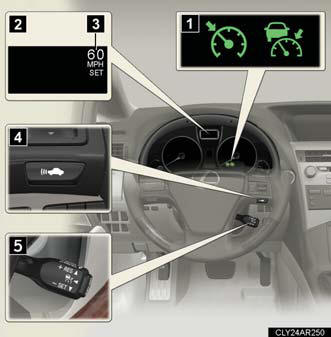
1. Indicators.
2. Display.
3. Set speed.
4. Vehicle-to-vehicle distance button.
5. Cruise control switch.
Setting the vehicle speed (vehicle-to-vehicle distance control mode)
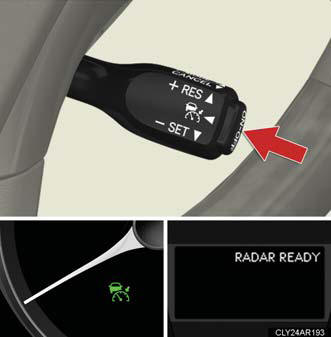
Press the “ON-OFF” button to activate the cruise control.
Press the button again to deactivate the cruise control.
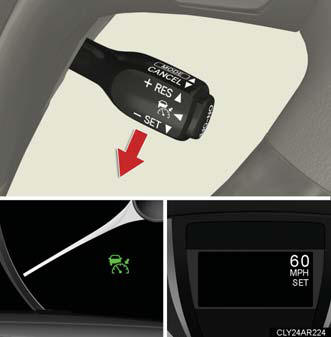
Accelerate or decelerate the vehicle to the desired speed, and push the lever down to set the speed.
“SET” will be displayed.
Adjusting the set speed
To change the set speed, operate the lever until the desired set speed is displayed.
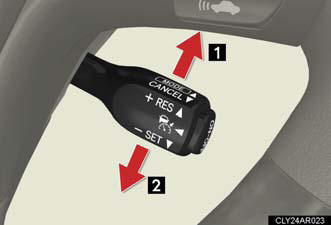
1. Increases the speed.
2. Decreases the speed.
Fine adjustment: Momentarily move the lever in the desired direction.
Large adjustment: Hold the lever in the desired direction.
In the vehicle-to-vehicle distance control mode, the set speed will be increased or decreased as follows: - When the set speed is shown in “MPH”.
Fine adjustment: By approximately 1 mph (1.6 km/h) each time the lever is operated.
Large adjustment: By approximately 5 mph (8 km/h) for each 0.75 seconds the lever is held.
- When the set speed is shown in “km/h”.
Fine adjustment: By approximately 0.6 mph (1 km/h) each time the lever is operated.
Large adjustment: By approximately 3.1 mph (5 km/h) for each 0.75 seconds the lever is held.
In the constant speed control mode, the set speed will be increased or decreased as follows: Fine adjustment: By approximately 1 mph (1.6 km/h) each time the lever is operated.
Large adjustment: The set speed can be increased or decreased continually until the lever is released.
Changing the vehicle-to-vehicle distance
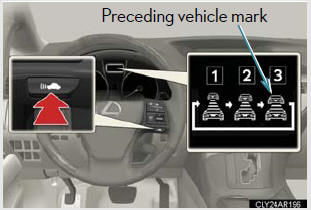
Pressing the button changes the
vehicle-to-vehicle distance as
follows:
1. Long.
2. Medium.
3. Short.
The vehicle-to-vehicle distance
is set automatically to long
mode when the “POWER”
switch is turned to ON mode.
If a vehicle is running ahead of you, the preceding vehicle mark will also be displayed.
Canceling and resuming the speed control
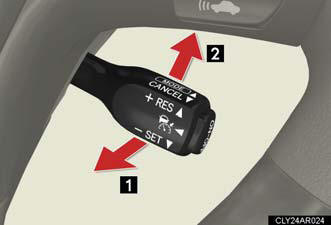
1. Pulling the lever toward you cancels the cruise control.
The speed setting is also canceled
when the brakes are
applied.
2. Pushing the lever up resumes the cruise control and returns vehicle speed to the set speed.
Resuming is available when the vehicle speed is more than approximately 25 mph (40 km/ h).
Driving in vehicle-to-vehicle distance control mode
This mode employs a sensor to detect the presence of vehicles up to approximately 400 ft. (120 m) ahead and to judge the distance between your vehicle and those the vehicle ahead of you.
Note that vehicle-to-vehicle distance will close in when traveling on long downhill slopes.
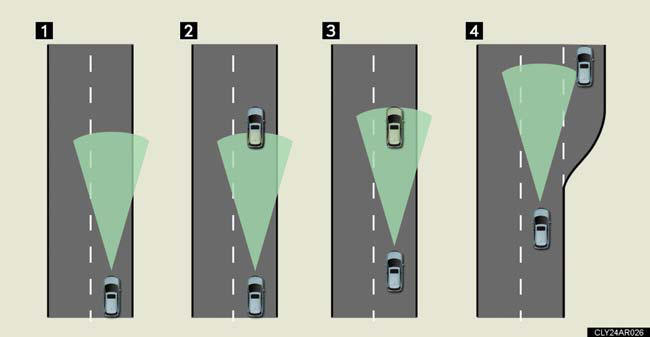
1. Example of constant speed cruising.
When there are no vehicles ahead.
The vehicle travels at the speed set by the driver. The desired
vehicle-to-vehicle
distance can also be set by operating the vehicle-to-vehicle distance control.
2. Example of deceleration cruising.
When the vehicle ahead is driving slower than the set speed.
When a vehicle is detected running ahead of you the system automatically
decelerates your vehicle. When a greater reduction in vehicle speed is
necessary,
the system applies the brakes. A warning tone warns you when the
system cannot decelerate sufficiently to prevent your vehicle from closing in
on the vehicle ahead.
3. Example of follow-up cruising.
When following a vehicle driving slower than the set speed.
The system continues follow-up cruising while adjusting for changes in the speed of the vehicle ahead in order to maintain the vehicle-to-vehicle distance set by the driver.
4. Example of acceleration.
When there are no longer any vehicles driving slower than the set speed.
The system accelerates until the set speed is reached. The system then returns to constant speed cruising.
Approach warning
When your vehicle is too close to a vehicle ahead, and sufficient automatic deceleration via the cruise control is not possible, the display will flash and the buzzer will sound to alert the driver. An example of this would be if another driver cuts in front of you while you are following a vehicle. Apply the brakes to ensure an appropriate vehicle-to-vehicle distance.
Selecting conventional constant speed control mode
Dynamic radar cruise control can be used as conventional cruise control if you select constant speed control mode.
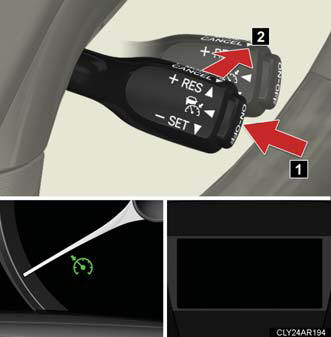
1. Press the “ON-OFF” button to activate the cruise control.
Press the button again to deactivate the cruise control.
Vehicle-to-vehicle distance control mode is always reset when the “POWER” switch is turned to ON mode.
2. Switch to constant speed control mode.
(Push the lever forward and hold for approximately one second.) Constant speed control mode indicator will come on.
Dynamic radar cruise can be set when
The shift lever is in the D or range “4” or higher of S has been selected.
Vehicle speed is above approximately 30 mph (50 km/h).
Switching modes
The mode cannot be switched to constant speed control mode if
vehicle-to-vehicle
distance control mode has been used. The mode also cannot be switched from
constant speed control to vehicle-to-vehicle distance control mode. Turn the
system
off by pressing the “ON-OFF” button, and turn it on again.
Accelerating
The vehicle can accelerate normally. After acceleration, the set speed resumes.
However, during vehicle-to-vehicle distance control mode, the vehicle speed may decrease below the set speed in order to maintain the distance to the vehicle ahead.
Automatic cancelation of vehicle-to-vehicle distance control
Vehicle-to-vehicle distance control driving is automatically canceled in the
following
situations:
Actual vehicle speed falls below approximately 25 mph (40 km/h).
VSC is activated.
The sensor cannot operate correctly because it is covered in some way.
The windshield wipers are operating at high speed.
When the snow mode is set.
If vehicle-to-vehicle distance control driving is automatically canceled for any
other
reason, there may be a malfunction in the system. Contact your Lexus dealer.
Automatic cancelation of constant speed control
The cruise control will stop maintaining the vehicle speed in the following
situations:
Actual vehicle speed is more than approximately 10 mph (16 km/h) below the
set vehicle speed.
At this time, the memorized set speed is not retained.
Vehicle speed falls below approximately 25 mph (40 km/h).
VSC is activated.
Vehicle-to-vehicle distance settings
Select a distance from the table below. Note that the distances shown
correspond
to a vehicle speed of 50 mph (80 km/h). Vehicle-to-vehicle distance increases/
decreases in accordance with vehicle speed.

Radar sensor and grille cover
Always keep the sensor and grille cover clean to ensure that the
vehicle-to-vehicle
distance control operates properly. (Some obstructions, such as snow, ice and
plastic
objects, cannot be detected by the obstruction sensor.)
Dynamic radar cruise control is canceled if an obstruction is detected.
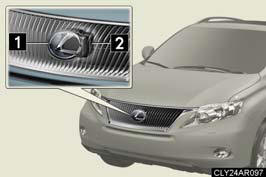
1. Grille cover.
2. Radar sensor.
Warning lights, messages and buzzers for dynamic radar cruise control
Warning lights, messages and buzzers are used to indicate a system
malfunction or
to inform the driver of the need for caution while driving.
Approach warning
In the following instances, there is a possibility that warnings will not
occur:
When the speed of the vehicle ahead matches or exceeds your vehicle speed.
When the vehicle ahead is traveling at an extremely slow speed.
Immediately after the cruise control speed was set.
At the instant the accelerator is applied.
Certification
- For vehicles sold in U.S.A.
FCC ID: HYQDNMWR005.
This device complies with Part 15 of the FCC Rules. Operation is subject to the
following
two conditions: (1) this device may not cause harmful interference, and (2)
this device must accept any interference received, including interference that
may
cause undesired operation.
FCC WARNING
Changes or modifications not expressly approved by the party responsible for
compliance could void the user’s authority to operate the equipment.
Radio frequency radiation exposure Information:
This equipment complies with FCC radiation exposure limits set forth for an
uncontrolled
environment.
This equipment should be installed and operated with minimum distance of 20 cm between the radiator and your body.
This transmitter must not be co-located or operating in conjunction with any
other
antenna or transmitter.
- For vehicles sold in Canada.
Operation is subject to the following two conditions: (1) this device may not
cause
interference, and (2) this device must accept any interference, including
interference
that may cause undesired operation of the device.
CAUTION:
Before using dynamic radar cruise control
Do not overly rely on vehicle-to-vehicle distance control.
Be aware of the set speed. If automatic deceleration/acceleration is not
appropriate,
adjust the vehicle speed, as well as the distance between your vehicle and
vehicles
ahead by applying the brakes etc.
CAUTION:
Cautions regarding the driving assist systems
Observe the following precautions.
Failure to do so may cause an accident resulting in death or serious injury.
Assisting the driver to measure following distance
The dynamic radar cruise control is only intended to help the driver in
determining
the following distance between the driver’s own vehicle and a designated
vehicle traveling ahead. It is not a mechanism that allows careless or
inattentive
driving, and it is not a system that can assist the driver in low-visibility
conditions. It
is still necessary for driver to pay close attention to the vehicle’s
surroundings.
Assisting the driver to judge proper following distance The dynamic radar cruise control determines whether the following distance between the driver’s own vehicle and a designated vehicle traveling ahead is appropriate or not. It is not capable of making any other type of judgement.
Therefore, it is absolutely necessary for the driver to remain vigilant and to
determine
whether or not there is a possibility of danger in any given situation.
Assisting the driver to operate the vehicle
The dynamic radar cruise control has no capability to prevent or avoid a
collision
with a vehicle traveling ahead. Therefore, if there is ever any danger, the
driver
must take immediate and direct control of the vehicle and act appropriately in
order to ensure the safety of all involved.
To avoid inadvertent cruise control activation Switch the cruise control off using the “ON-OFF” button when not in use.
CAUTION:
Situations unsuitable for dynamic radar cruise control
Do not use dynamic radar cruise control in any of the following situations.
Doing so may result in inappropriate speed control and could cause an accident resulting in death or serious injury.
In heavy traffic.
On roads with sharp bends.
On winding roads.
On slippery roads, such as those covered with rain, ice and snow.
On steep downhills, or where there are sudden changes between sharp up and down gradients.
Vehicle speed may exceed the set speed when driving down a steep hill.
At entrances to expressways.
When weather conditions are bad enough that they may prevent the sensors from functioning correctly (fog, snow, sandstorm, heavy rain, etc.).
When an approach warning buzzer is heard often.
When your vehicle is towing a trailer (AWD models with towing package) or
during
emergency towing.
When the sensor may not be correctly detecting the vehicle ahead.
Apply the brakes as necessary when any of the following types of vehicles are in front of you.
As the sensor may not be able to correctly detect these types of vehicles, the approach warning will not be activated, and a fatal or serious accident may result.
Vehicles that cut in suddenly.
Vehicles traveling at low speeds.
Vehicles that are not moving.
Vehicles with small rear ends (trailers with no load on board etc.).
Motorcycles traveling in the same lane.
CAUTION:
Conditions under which the vehicle-to-vehicle distance control may not
function
correctly
Apply the brakes as necessary in the following conditions as the radar sensor
may
not be able to correctly detect vehicles ahead, and a fatal or serious accident
may
result:
When water or snow thrown up by the surrounding vehicles hinders the
functioning
of the sensor.
When your vehicle is pointing upwards (caused by a heavy load in the luggage compartment etc.).
When the road curves or when the lanes are narrow.
When steering wheel operation or your position in the lane is unstable.
When the vehicle ahead of you decelerates suddenly.
Handling the radar sensor.
Observe the following to ensure the cruise control system can function effectively.
Otherwise, the system may not function correctly and could result in an accident.
Keep the sensor and front grille cover clean at all times.
Clean the sensor and front grille cover with a soft cloth so you do not mark or damage them.
Do not subject the sensor or surrounding area to a strong impact.
If the sensor moves even slightly off position, the system may malfunction. If
the
sensor or surrounding area is subject to a strong impact, always have the area
inspected and adjusted by a Lexus dealer.
Do not disassemble the sensor.
Do not attach accessories or stickers to the sensor, grille cover or
surrounding
area.
Do not modify or paint the sensor and grille cover.
Do not replace them with non-genuine parts.
See also:
List of storage features
1. Glove box.
2. Overhead console.
3. Cup holders.
4. Console box.
5. Auxiliary box. ...
Pre-Collision System
When the radar sensor detects an unavoidable frontal collision, safety
systems
such as the brakes and seat belts are automatically engaged in an
attempt to lessen vehicle damage.
Pre-collision se ...
Safety Connect
Safety Connect is a subscription-based telematics service that uses Global
Positioning System (GPS) data and embedded cellular technology to provide
safety and security features to subscribers. Safe ...
